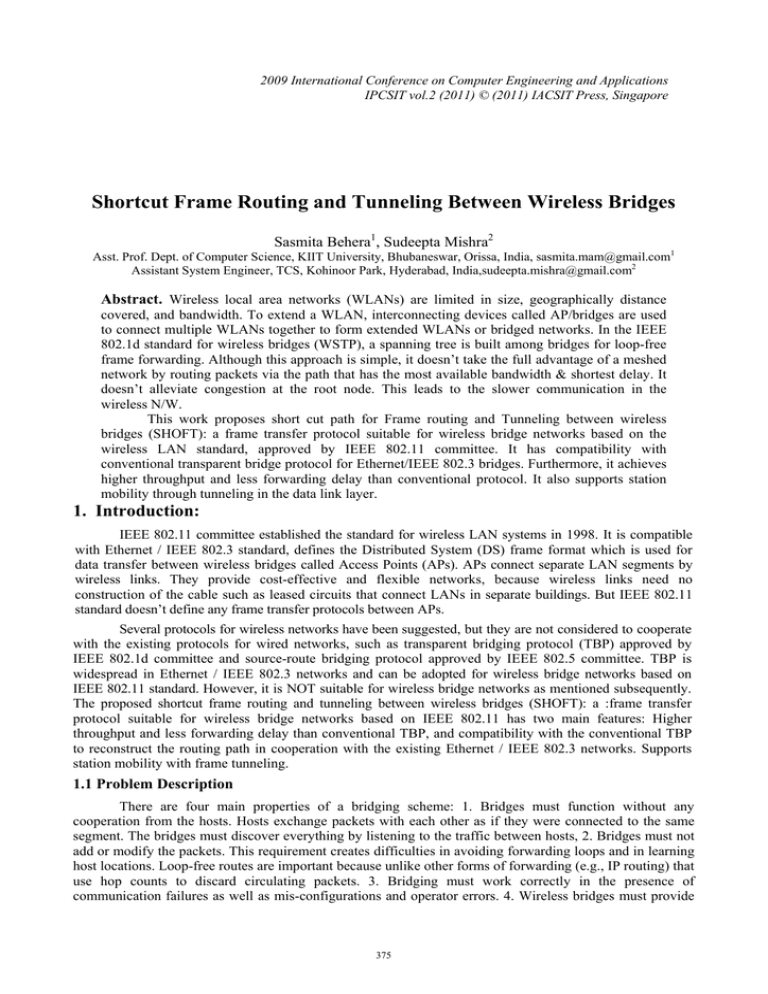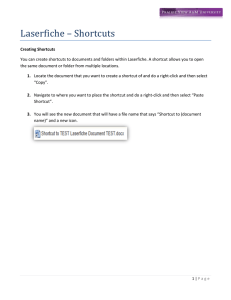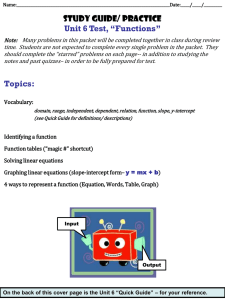Document 13134199
advertisement

2009 International Conference on Computer Engineering and Applications IPCSIT vol.2 (2011) © (2011) IACSIT Press, Singapore Shortcut Frame Routing and Tunneling Between Wireless Bridges Sasmita Behera1, Sudeepta Mishra2 Asst. Prof. Dept. of Computer Science, KIIT University, Bhubaneswar, Orissa, India, sasmita.mam@gmail.com1 Assistant System Engineer, TCS, Kohinoor Park, Hyderabad, India,sudeepta.mishra@gmail.com2 Abstract. Wireless local area networks (WLANs) are limited in size, geographically distance covered, and bandwidth. To extend a WLAN, interconnecting devices called AP/bridges are used to connect multiple WLANs together to form extended WLANs or bridged networks. In the IEEE 802.1d standard for wireless bridges (WSTP), a spanning tree is built among bridges for loop-free frame forwarding. Although this approach is simple, it doesn’t take the full advantage of a meshed network by routing packets via the path that has the most available bandwidth & shortest delay. It doesn’t alleviate congestion at the root node. This leads to the slower communication in the wireless N/W. This work proposes short cut path for Frame routing and Tunneling between wireless bridges (SHOFT): a frame transfer protocol suitable for wireless bridge networks based on the wireless LAN standard, approved by IEEE 802.11 committee. It has compatibility with conventional transparent bridge protocol for Ethernet/IEEE 802.3 bridges. Furthermore, it achieves higher throughput and less forwarding delay than conventional protocol. It also supports station mobility through tunneling in the data link layer. 1. Introduction: IEEE 802.11 committee established the standard for wireless LAN systems in 1998. It is compatible with Ethernet / IEEE 802.3 standard, defines the Distributed System (DS) frame format which is used for data transfer between wireless bridges called Access Points (APs). APs connect separate LAN segments by wireless links. They provide cost-effective and flexible networks, because wireless links need no construction of the cable such as leased circuits that connect LANs in separate buildings. But IEEE 802.11 standard doesn’t define any frame transfer protocols between APs. Several protocols for wireless networks have been suggested, but they are not considered to cooperate with the existing protocols for wired networks, such as transparent bridging protocol (TBP) approved by IEEE 802.1d committee and source-route bridging protocol approved by IEEE 802.5 committee. TBP is widespread in Ethernet / IEEE 802.3 networks and can be adopted for wireless bridge networks based on IEEE 802.11 standard. However, it is NOT suitable for wireless bridge networks as mentioned subsequently. The proposed shortcut frame routing and tunneling between wireless bridges (SHOFT): a :frame transfer protocol suitable for wireless bridge networks based on IEEE 802.11 has two main features: Higher throughput and less forwarding delay than conventional TBP, and compatibility with the conventional TBP to reconstruct the routing path in cooperation with the existing Ethernet / IEEE 802.3 networks. Supports station mobility with frame tunneling. 1.1 Problem Description There are four main properties of a bridging scheme: 1. Bridges must function without any cooperation from the hosts. Hosts exchange packets with each other as if they were connected to the same segment. The bridges must discover everything by listening to the traffic between hosts, 2. Bridges must not add or modify the packets. This requirement creates difficulties in avoiding forwarding loops and in learning host locations. Loop-free routes are important because unlike other forms of forwarding (e.g., IP routing) that use hop counts to discard circulating packets. 3. Bridging must work correctly in the presence of communication failures as well as mis-configurations and operator errors. 4. Wireless bridges must provide 375 station mobility. Agreeing on a stable state of the network in the presence of such failures is a difficult problem. Note: If the Ethernet packet format had an additional field, say a simple hop count field, the problems of circulating packets and host location could be trivially solved. [2][3] 1.2 Minimum Requirements for Packet Flood: Although the basic frame that is transmitted in the wireless medium conform to 802.11 MAC frame format, they are converted to 802.3 MAC frame format before forwarding the packets towards the destination using filtering database (FDB) so the minimum criteria for Ethernet loop also applies here. Those criteria’s are: 1. There should be redundant path between bridges constituting a close circuit, and the path should be bidirectional else loop may not give rise to packet flood. 2. Frame destination should not be known exactly which ever is coming in to the loop. All these should give rise to instability in the bridge learn table, Then frames coming will be replicated and regenerated to give rise a packet flood. [4] 2. Proposed Solution for Loop Control & Mobility Here an overview of (SHOFT) and its working procedure is presented. The main design goals in this protocol are: backward compatibility, preventing useless transmission problem of conventional TBP, Shortcut frame transmission, preventing short cut table pollution, support for Station roaming, and MAC in MAC tunneling for seamless connectivity. By being backward compatible with the WSTP (wireless extension of IEEE 802.Id standard) the new protocol operates seamlessly with the current STP AP Bridges. It route frames over shortcut path then long redundant paths and solves the useless transmission problem in conventional TBP. APs have two new kinds of table: a topology table and a shortcut table. 3 2 Suspended Blocking 4 ID of Suspended port Listening 1 2 2. 3. 4. Routing Informa tion Learning 3 2 AP who has sent the RN packet Forwarding 1. ID of Port receiving RN Spanning Tree Algorithm selects as Designated or Root Port. Spanning Tree Algorithm selects as non Designated or Root Port. Protocol timer expiry (Forwarding Timer). Suspend notification signal is received. AP from which All the APs RN signal has between source been received and destination of RN Fig 2: structure of the topology table Fig 1: State Transition Diagram 2.1 Preventing useless transmission using Suspended State First, Suspend state is introduced instead of blocking state in conventional TBP. Figure 1 shows a transition diagram of port states. [8] The APs carry out STP and decide the state of each port, convert the blocking port to suspended port, and directly transmit a suspend notification signal (SN) to neighbor APs from suspended ports. When APs receive the SN, they change the state of the ports receiving it into Suspend state. The Suspend port doesn't transmit any broadcast or unicast frames, except for shortcut frames mentioned later. The APs change the state of Suspend ports into Listening state when they detect a topology change by STP. Note: The ports that received SN signal are previously in forwarding state but the port associated to it was blocking so the forwarding port tries to forward a packet but the blocking port will receive it and reject it in wired medium it just wastes the link bandwidth but in wireless medium as the channel is shared between all the nodes and APs so all of them will be affected and the throughput will decrease. 376 2.1 Topology Table Construction Secondly, shortcut frame transfer is introduced in addition to conventional frame transfer based on TBP. APs carry out a route notification procedure after they establish a tree path and SN signal. APs with Suspend ports send a route notification signal (RN) to neighbor APs opposite to suspend ports using conventional protocol. APs on a tree path between the source AP of RN and the destination AP of RN add their MAC address to the RN's routing information field when they forward an RN based on their FDB and STP. The destination AP of RN registers routing information of neighbor APs opposite to Suspend ports in its topology table when it receives RN. Figure 2: shows the details of the topology. Figure 3 shows an example of wireless bridge network after sending SN signal and RN signal which converts the blocking state of the port to suspended state and construct the topology table. STA 2 RN AP2 S AP3 S AP2 AP1 F F S SN S F S S F S AP3 SN AP1 F F F SN RN S F STA 1 F AP4 S F S S STA 4 AP1 ID of suspended port ID of port receiving RN Routing information AP2 AP1 AP1 AP3 AP1 AP1 Fig 3: wireless Bridge with SN & RN F AP4 S STA 3 Tree path STP Topology table for AP4 F AP2 STA1 STA2 Shortcut Table of AP4 STA Address Shortcut Address STA2 AP2 Fig 4: Frame monitoring and shortcut address registration. 2.2 Short Cut Path Discovery Now to forward shortcut frames short cut table need to be constructed for that APs carry out a monitoring procedure. They monitor WDS frames transmitted by the APs on the opposite side of their suspended wireless links, (except those APs connected directly on a tree path) and check the MAC address fields of monitored frames SA and TA which are of their interest. If the AP that the RA indicates is on a tree path between the AP that the TA indicates and the monitoring AP, in other words, if the monitored frame is forwarded the monitoring AP's way, the monitoring AP will register TA as a shortcut address of the STA that the SA indicates in its shortcut table, else then don’t add SA to the shortcut table. Figure below shows frame monitoring and shortcut address registration. The shortcut table also needs to be updated. When APs monitor that a frame whose SA equals an STA address registered in shortcut table but the TA differs from the registered shortcut address forwarded their way, they compare the distance between the AP that the TA indicates and that of the AP that the shortcut address indicates. The AP's distance means the number of hops between APs. If the distance of the AP that TA indicates is bigger than that of the AP that the shortcut address indicates, the APs register TA as the shortcut address of the STA that SA indicates and update their shortcut tables else don’t add this short to the shortcut table. The above figure shows frame monitoring and shortcut address usage. APs also have a delete procedure for the shortcut table. APs delete the STA address from the shortcut table when they can't monitor that the frame who’s SA equals the registered STA address is forwarded their way during a predefined period: shortcut aging time. That period is shorter than the aging time of FDB. When the DA of frames has been registered in the shortcut tables, the APs directly transmit the frames from their suspend port to the opposite AP that the shortcut address indicates. 2.3 Mobility through MAC Tunneling 377 When a station moves from one AP to another and both are connected by WDS link, a handoff is required for seamless connectivity. If the client determines that there is a stronger signal from a different access point, the client re-associates with the new access point, the station will not attempt to roam until it drops below a manufacturer-defined signal strength threshold. The steps in station roaming are: 1.New AP discovery and 2.Re-authentication. Figure 6 explains the procedure. AP discovery: It can be done by active or passive scanning so that it can find APs with different SSID as WDS doesn’t put any restriction that all APs should have same SSID as in ESS. Re-authentication: The station attempts to re-authenticate to a new AP. The re-authentication process typically involves an authentication and a re-association to the new AP. The re-authentication phase involves the transfer of credentials and other state information from the old-AP. This can be achieved through a protocol such as IAPP (Inter Access Point Protocol). The station will tell the new AP about the it’s old AP in the old network, the new AP will first re-authenticate the station, then the new AP will tell old AP to buffer the intermediate frames and transfer them to it, but it can not be transferred, because it may pollute the Shortcut Table of monitoring APs, so a tunnel should be created to transmit those packets from old AP to new AP, a MAC in MAC tunneling similar to IP tunneling can be used, so that other monitoring nodes can’t monitor those frames. In future when the roamed station will transmit any frame the other APs will monitor the transmission form the mobile station and update their shortcut table accordingly. If at any case it need to be sent to a wired network the frame will be de-capsulated and will be sent to the wired medium the same is true for an AP that is not participating in short cut transfer. The figure above shows the frame tunneling between old AP and new AP. [5] 2.4 Restrictions for Short Cut Transmission APs do not transmit broadcast frames with a shortcut. APs forward broadcast frames along a tree path based on TBP. In the IEEE 802.1d standard a tree is used, so there is no closed path, and broadcast packets can’t create. 3. Conclusion: Higher throughput and less forwarding delay than conventional TBP is achieved in comparison to the conventional protocol over wireless bridge networks based on IEEE 802.11 standard and FRASH because: Introduction of suspended states solves the useless transmission problem which is responsible for useless channel utilization and the tree segment connecting monitoring and monitored APs are by passed for shortcut frames, so frames follows less number of hops hence lowers frame forwarding delay, and at the same time distributes network load over alternative paths, and lowers congestion at root node. Compatibility with the conventional TBP to reconstruct the routing path in cooperation with the existing Ethernet/IEEE 802.3 networks is also an added feature. It improves the throughput characteristics compared to the conventional protocol (TBP), and increases as traffic increases. As broadcast frames increases, throughput degrades. However, the proposal keeps its advantage because redundant transmission increases in conventional protocol (TBP). AP2 STA 2 AP1 STA 5 F F S S AP3 AP4 S F F STA 5 F F S F S S MAC in MAC tunneling STA 1 S F AP7 S F F STA 7 AP5 Fig 5: Station roaming with MAC in MAC tunneling But, as “broadcasted packets” never use shortcut paths but only use tree paths so there is no enhancement of 378 those packets in terms of throughput in this technique in comparison to STP. The research is still going on mobility support at new AP for the enhancements in network security and communication purposes. Fig 6: Hand off procedure and frame tunneling References: [1]. Takeo Ichikawa, Masataka Iizuka, Masahiro Morikura, and Hideaki Matsui “Wireless Bridging and Routing Method Employing a Novel Frame Transfer Protocol with Shortcut” Proc. Of Vehicular Technology Conference 2003-Spring. The 57th IEEE Semiannual. [2]. Thomas L. Rodeheffer, Chandramohan A. Thekkath, Darrell C. Anderson, “Smart Bridge: A Scalable Bridge Architecture”, ACM publication, SIGCOMM '00, Proceedings of the conference on Applications, Technologies, Architectures, and Protocols for Computer Communication. [3]. King-Shan Lui, Whay Chiou Lee, Klara Nahrstedt, “STAR: A Transparent Spanning Tree Bridge Protocol with Alternate Routing”, ACM SIGCOMM Computer Communication Review Volume 32, Issue 3 (July 2002) Year of Publication: 2002. [4]. Behrouz A. Forouzan, “Data communication and networking, 3rd edition”, TATA McGRAW-HILL Edition: 2004, ISBN: 0-07-251584-8 Chapter-16. [5]. "IEEE 802.11 Draft Standard for wireless LAN D6.1," 1997. [6]. White Paper: “Wireless Spanning Tree” http://www.nowire.se/produktblad/Compex/Compex_STP.pdf [7]. “The Wireless Spanning Tree Protocol”, Shah Rahman, Cisco Proposal to 802.11TGs [8]. Tony Kenyon, “High-performance Data Network Design”, Digital Press; 1st edition (December 2001), ISBN:9781555582074, Page number: 517-519 379



